The remote and isolated Galapagos Islands sit 600 miles (965 km) off the coast of Ecuador in the Pacific Ocean. The island group, consisting of 13 main islands and six smaller isles, is world-renowned for its unique wildlife, both above and below the water. The islands are part of one of the largest protected areas in the world, and thusly are still rich with marine life. The best way to dive the Galapagos is via liveaboard, but book early because these trips sell fast.
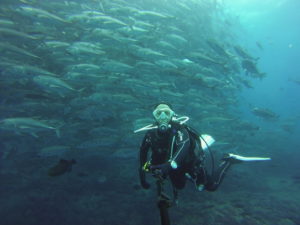
As the seasons change, so too do wildlife-viewing opportunities. December through May is the warm season, with the highest water and air temperatures. Waters hover between 70 and 86F (21 to 30 C) with some cooler thermoclines at depth This season also brings the best visibility. June through November is known as "guarua," and is cooler with frequent mist and overcast days. Water temperatures are between 60 and 75 F (16 to 24 C). While colder, the tradeoff is the rich currents bringing nutrients into the islands, resulting in more abundant marine life. Visibility is slightly lower as a result. During either season, however, divers will be overwhelmed with the sheer abundance of life here. Here are five of the top marine encounters in the Galapagos Islands.
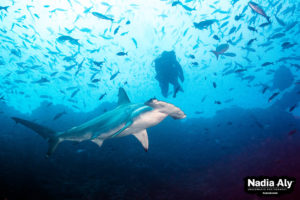
Hammerhead shark
Giant schools of scalloped hammerheads are by far the Galapagos' most iconic marine sight. Groups of hundreds of individuals aren't uncommon. The exact reason behind this schooling behavior remains a mystery, but you can see the sharks all year round. They are most abundant from December through May. The best dive sites for hammerheads are at Wolf and Darwin Islands.
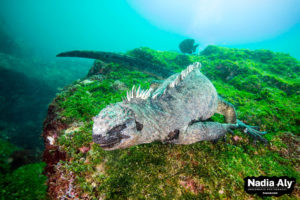
Marine iguana
You'll find the Galapagos marine iguana only in the Galapagos Islands. These photogenic lizards can forage in the sea, making them marine reptiles. Scientists think a lack of food on land forced the animals to evolve into swimmers. The abundant algae in the shallow waters makes up the bulk of their diet now. They are excellent swimmers and you will see them swimming overhead on the surface and flying around underwater, stopping off at rocks to eat algae. You may see anywhere from 10 to 20 iguanas during one dive in coastal regions on the islands of Isabela, Fernandina, Espanola, Floreana and Santa Cruz. These year-round residents are active during the day and spend a lot of time on rocks basking in the sun. Diving with them will leave you feeling like you've gone back to prehistoric times.
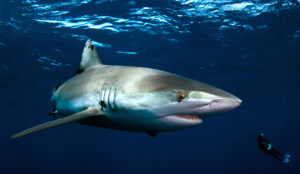
Galapagos shark
You'll see many types of sharks in the Galapagos, and although this one is named for the islands, the Galapagos shark is not endemic. It was, however, first discovered here. These sharks are quite large and have streamlined bodies, quite similar to reef sharks. Galapagos sharks are common at Wolf and Darwin Islands year-round, and you may see 10 or more of them on a dive.
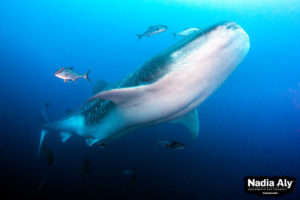
Whale shark
Seeing a whale shark makes for a mind-blowing sight during a dive. Peak whale-shark season falls from July to November when they come to feed in the nutrient-rich waters. You may see up to three during a dive depending on how lucky you are. Again, the best sites for whale sharks are at Wolf and Darwin Islands. These are the can't miss dives, so choose a liveaboard that spends the most time here to give you the best chance to see the most marine life.
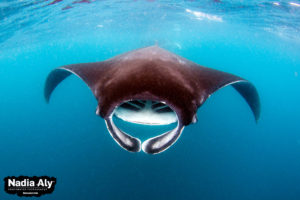
Manta ray
Mantas gather in the Galapagos in large numbers from December to May, during the warm season. Even if you've dived with them before, their abundance here will nonetheless impress you. You can see them at a variety of dives sites including Cabo Marshall, Wolf and Darwin.
Under threat
With the recent capture of illegal Chinese fishing vessels found full of thousands of sharks in the Galapagos, it is time now more than ever to expand the marine-protected area around the islands to include the sharks' migratory paths to Cocos and Malpelo Islands. Without this protection and effective management, this world treasure is under threat. As the ocean empties of fish, more illegal vessels will ply the waters as long as there is a demand. By diving in the Galapagos, we help make tourism a bigger financial asset to Ecuador than fishing. Support online petitions to protect the ocean, volunteer your time with worthy causes and consider cutting seafood out of your diet entirely.
The post Top Five Marine Encounters in the Galapagos Islands appeared first on Scuba Diver Life.
from Scuba Diver Life http://ift.tt/2tWIxRj
No comments:
Post a Comment